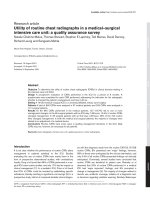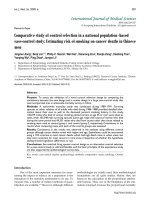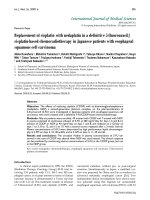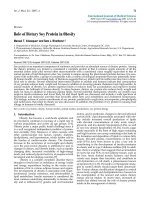Báo cáo y học: " Influenza Vaccination: Healthcare Workers Attitude in Three Middle East Countrie"
Bạn đang xem bản rút gọn của tài liệu. Xem và tải ngay bản đầy đủ của tài liệu tại đây (283.42 KB, 7 trang )
Int. J. Med. Sci. 2010, 7
319
I
I
n
n
t
t
e
e
r
r
n
n
a
a
t
t
i
i
o
o
n
n
a
a
l
l
J
J
o
o
u
u
r
r
n
n
a
a
l
l
o
o
f
f
M
M
e
e
d
d
i
i
c
c
a
a
l
l
S
S
c
c
i
i
e
e
n
n
c
c
e
e
s
s
2010; 7(5):319-325
© Ivyspring International Publisher. All rights reserved
Research Paper
Influenza Vaccination: Healthcare Workers Attitude in Three Middle East
Countries
Eman Abu-Gharbieh
1
, Sahar Fahmy
2
, Bazigha Abdul Rasool
1
,
Saeed Khan
1
1. Dubai Pharmacy College, Dubai, United Arab Emirates;
2. Faculty of Pharmacy, Helwan University, Helwan, Egypt
.
Corresponding author: Eman Abu-Gharbieh, PhD, Department of Pharmacology and Therapeutics, Dubai Pharmacy
College, Dubai, United Arab Emirates, P.O Box 19099, Fax: +971 4 2646740, Telephone : +971 4 2120310; E-mail: eman-
Received: 2010.06.30; Accepted: 2010.09.07; Published: 2010.09.21
Abstract
Background: Healthcare workers (HCWs) pose a potential risk of transmitting commu-
nicable diseases in the hospital settings where they usually work. This s t u d y a i m s t o d e t e r m i n e
the current influenza vaccination rates among HCWs in three Middle East countries namely
United Arab Emirates (UAE), Kuwait and Oman, and also to identify the different variables
associated with the noncompliance of HCWs to the recommendations of the Advisory
Committee on Immunization Practices (ACIP) set in those countries. M et hods: 1500 ques -
tionnaires were distributed to health care workers in the three countries during the period of
July-October 2009. Results: Among 993 respondents, the vaccination rate was 24.7%, 67.2%
and 46.4% in UAE, Kuwait and Oman, respectively. The different motivating factors that in-
fluenced the health care workers to take the vaccine was assessed and found that the most
c o m m o n f a c t o r t h a t i n f l u e n c e d t h e i r d e c i s i o n t o t a k e t h e v a c c i n e w a s f o r t h e i r s e l f p r o t e c t i o n
(59%). On the other hand, the most common reason that discouraged HCWs to take the
vaccine was “lack of time” as reported by 31.8% of the respondents. Other reasons for not
taking the vaccine were unawareness of vaccine availability (29.4%), unavailability of vaccine
(25.4%), doubts about vaccine efficacy (24.9%), lack of information about importance (20.1%)
and concerns about its side effects (17.3%). Conclusions: influenza immunization by
healthcare workers in the studied countries was suboptimal which could be improved by
setting different interventions and educational programs to increase vaccination acceptance
among HCWs.
Key words: Influenza, healthcare workers, vaccination
INTRODUCTION
Healthcare workers (HCWs) pose a potential
risk of transmitting communicable diseases in the
hospital settings where they usually work.
1
Healthy
individuals who are infected with influenza virus,
including those with subclinical infections, can
transmit influenza virus to other individuals who are
at higher risk of complications from influenza
2
i.e.
elderly and immune-compromised patients. As these
patients belong to the risk groups, they must be vac-
cinated against influenza. Vaccination rates among
t h e s e g r o u p s v a r y w i d e l y a m o n g c o u n t r i e s a n d e v e n i f
vaccinated, it is reported that the efficacy of influenza
vaccination are lower than that of younger adults
which necessities their indirect protection against in-
fluenza infections through vaccinating HCWs.
3
Influenza vaccination of HCW reduces the risk
of infection, influenza-like-illness and absenteeism
among staff
4
and appears to prevent nosocomial in -
Int. J. Med. Sci. 2010, 7
320
fections and associated morbidity and mortality
among their patients.
5
For these reasons, influenza
vaccination of HCWs is recommended by The World
Health Organization (WHO), US Center for Disease
Control and Prevention (CDC) and the immunization
guidelines set by many countries to prevent the
transmission of influenza virus from HCWs to pa-
tients.
6
It is reported that there is a low uptake of in-
fluenza vaccination among HCWs despite the availa-
bility of immunization guidelines in many coun-
tries.
7,8
In the US for example, the vaccination rate
among HCWs was only 43 % i n 2005.
8
Most of the Middle East countries adopt the
recommendations and guidelines set by the interna-
tional health agencies and provide vaccination pro-
grams to all HCWs against influenza virus both sea-
sonal and pandemic. In the United Arab Emirates for
example, in 2009, the pandemic influenza vaccines
were distributed to all health care facilities and were
available free of charge to the most vulnerable group
based on priorities as follow; pilgrims, adults with
chronic diseases, Health care workers who are in di-
rect contact with patients with the priority for emer-
g e n c y r o o m ( E R ) , I n t e n sive care unit (ICU), outpatient
clinics and Primary health centers (PHC) healthcare
workers.
9
However, the rate of influenza immuniza-
tion among HCWs and barriers to influenza vaccina-
tions are not fully addressed in the Middle East
countries.
The purpose of the present study is to determine
the current vaccination rates of HCWs in three Gulf
countries: United Arab Emirates (UAE), Kuwait and
Oman and also, to identify the different variables as-
sociated with the noncompliance of HCWs to the
recommendations of the Advisory Committee on
Immunization Practices (ACIP) set in these countries.
The study intends to aid the regulatory bodies to im -
plement effective interventions that would raise the
rate of influenza immunization among HCWs.
METHODS
1500 questionnaires were either personally dis-
tributed to HCWs or through their Health Care Facil-
i t y ( H C F ) a d m i n i s t r a t i v e c h a n n e l s b y i n t e r n a l e m a i l o r
mail. The questionnaires were randomly distributed
in pre-selected health care facilities i.e. three main
hospitals, five polyclinics and medical centers in each
country during the period of July-October 2009.
The questionnaire was delivered to the study
populations; nurses working in ICU, pediatrics, ge-
riatrics, acute medical care, gynecology and emer-
gency departments; doctors, GPs, nephrologists,
dentists, pediatricians and allied health care profes-
sionals i.e. radiographers, laboratory technicians and
administrators.
Participants were given a brief introduction on
the aim of the study, instructions on how to complete
t h e s u r v e y a n d o n h o w t o r e t u r n t h e c o m p l e t e d f o r m s .
A period of one week was allowed for submitting the
completed questionnaire, so as to ensure maximum
participation of staff working in different shifts.
The questionnaire assessed HCWs uptake of in-
fluenza vaccination, reasons for vaccine uptake for
vaccinated workers, and reasons for vaccination re-
fusal for those who had declined taking the vaccine.
The questionnaire composed of two parts; Part 1 ad-
dressed the demographic information of the partici-
p a n t s , h i s t o r y o f i n f l u e n z a l i k e s y m p t o m s ( f r e q u e n c y ) ,
absence from work due to influenza illness, frequency
of receiving vaccination (if taken on regular basis),
participants’ knowledge of Centre of Disease Control
(CDC) recommendations on seasonal influenza. P a r t 2
comprised of subdivisions, the first group of ques-
tions were addressed to those who had received the
vaccine and enquired about reasons for taking the
vaccine, time of vaccine administration and whether
vaccine intake was beneficial.
The second group of questions were addressed
to those who did not receive the influenza vaccina-
tion, and assessing different factors that might have
inhibited their influenza vaccine uptake.
The study protocol was approved by the Re-
search and Ethics Committee at Dubai Pharmacy
College and approval for distributing the question-
naire was obtained from the administration of each
health care facility (HCF) participated in the survey.
The study protocol was also approved by internal
committees of the participated health care facilities.
Data Analysis
Data were entered and analyzed using SPSS
software version 17; (SPSS
®
, Inc, Chicago, IL). Statis-
tical analyses were performed using χ
2
tests for com -
parison between bivariate variables. Multivariate lo-
gistic-regression analysis was conducted to examine
the associations between the outcome and all inde-
pendent variables.
RESULTS
Of the 1500 distributed questionaiers, 993 HCWs
completed and returned the questionnaire with a total
response rate of 66.2% in the three Middle East
countries with the highest response rate from Kuwait;
where 300 questionairre were distributed and 232
(77.3%) completed the questionairre. In Oman, 600
questionairre were distributed and 360 (60%)
c o m p l e t e d t h e s u r v e y . I n UAE, 691 questionairre were
Int. J. Med. Sci. 2010, 7
321
distributed and 401(58%) had completed and returned
the survey. Approximately, seventy percent of the
respondents were in the age range of 25- 4 5 y e a r s w i t h
the majority of the respondents being female (65.4%).
The majority of the participants (66.5%)were
professional staff. Data on the demographic
information of participants are summarized in Table
1.
The study results showed that a total of 42.5% of
all the respondents self reported influenza vaccination
in the three countries. There was a statistically
significant difference in the rate of vaccination among
participants in the three countries (p-value <0.0001)
with the highest vaccination rate in Kuwait (67.2%)
compared to 46.4% in Oman and only 24.7% in UAE.
A small proportion of the respondents reported
t h a t t h e y g o t i n f l u e n z a l i k e s y m p t o m s o n r e g u l a r b a s i s
(11.6%) and the majority of the participants reported
that they got it rarely (53.0%). When the respondents
were asked about their awaeness of the CDC
recomendations for influenza vaccination, around
f i f t y o n e p e r c e n t o f t h e r e s p o n d e n t s r e p o r t e d t h a t t h e y
are aware of the CDC recommendations regarding
immunization against seasonal influenza. Data are
summarized in table 1.
The association between the respondents’
charactarestics and the vaccination status were tested
to identify the different variables associated with the
likelihood of vaccination aganist influenza among
HCWs. The data are summarized in table 2. T h e r e was
no significant association between HCWs age and the
vaccination status in both UAE and Kuwait with a
p-value > 0.05 (χ
2
test) with highest vaccination rate
being within the age range of > 45 years (32.2%)in
UAE and within the age range of 36-45 years of age
(69.5%) in Kuwait.In Oman, there was a significant
difference in the vaccination rate among the different
age groups (P = 0.005) with the age range of 36-45
years of age (56.3%) having the highest vaccination
rate. The lowest vaccination rate was within the age
range below 25 years of age(25.5%).
Results also showed that gender does not have
any statistically significant effect on t h e vacc i n a t i on
rate of the participants with a p-value = 0.05 (χ
2
t e s t ) i n
the three participated countries.
The attitude of HCWs’ were also analyzed to see
if their decision to take influenza vaccination were in
any way influenced by their previous history of in-
fliction with influenza like symptoms. Results from
UAE and Kuwait showed that there is no association
between respondents’ previous history of influenza
illness and their vaccination status (p-v a l u e > 0.05, χ
2
test) in fact in Oman, the highest vaccination rate
(66.4%) was obtained for individuals who never got
influenza like symptoms. Multivariate analysis of the
results showed that having history of influenza illness
was less likely to occur in the vaccinated group in
Oman (OR=0.662). Data are shown in table 2.
Table 1. Characteristics of respondent to the influenza vaccine survey of health care workers (**: Significance level < 0.005)
Character Country
UAE
n (%)
Kuwait
n (%)
Oman
n (%)
Total
n (%)
Age <25yrs 31 (7.7) 3 (1.6) 47 (13.1) 79 (8.0)
25-35yrs 163 (40.6) 18 (7.8) 170 (47.2) 351 (35.3)
36-45yrs 120 (29.9) 141 (60.7) 87 (24.2) 350 (35.2)
>45yrs 87 (21.7) 70 (30.2) 56 (15.6) 213 (21.5)
Gender Male 115 (28.8) 107 (46.1) 122 (33.9) 344 (34.6)
Female 286 (71.2) 125 (53.9) 238 (66.1) 649 (65.4)
Professional group Professionals 224 (55.9) 182 (78.4) 254 (70.6) 660 (66.5)
Paramedic 103 (25.7) 43 (18.5) 46 (12.8) 192 (19.3)
Other 74 (18.5) 7 (3.0) 60 (16.7) 141 (14.2)
Previous history of Influenza Never 160 (39.9) 76 (32.8) 116 (32.2) 352 (35.4)
Regularly 41(10.2) 33 (14.2) 41 (11.4) 115 (11.6)
Rarely 200 (49.9) 123 (53.0) 203 (56.4) 526 (53.0)
Awareness of CDC recom-
mendation
Yes 195 (48.6) 110 (47.4) 177 (49.2) 482 (48.5)
No 206 (51.4) 122 (52.6) 183 (50.8) 511 (51.5)
Vaccination Vaccinated 99(24.7) 156(67.2) 167(46.4) 422 (42.5)**
Total 401 232 360 993
Int. J. Med. Sci. 2010, 7
322
T a b l e 2 . Bivariate analysis of association between vaccination status and respondent characteristics and multivariate analysis
of likelihood of vaccination.
Character UAE (%) Kuwait (%) Oman (%)
Vacci-
nated
Non- vac-
cinated
Biva-
riate P
Vacci-
nated
Non- vac-
cinated
Biva-
riate P
Vacci-
nated
non-
vacci-
nated
Biva-
riate P
OR (95%CI)
Age <25 13 87.1 33.3 66.7 25.5 74.5 0.788
(0.614-1.011)
25-35 22.1 78 50 50 44.7 55.3
36-45 25.8 74.2 69.5 30.5 56.3 43.7
>45 32.2 67.8 0.131 65.7 34.3 0.326 53.6 46.4 0.005
Gender Male 29.6 70.4 62.6 37.4 48.4 51.6
Female 22.7 76.9 0.156 71.2 28.8 0.165 45.4 54.6 0.591
Professional
group
Professionals 26.3 73.7 75 25 50 50
Paramedic 25.2 74.8 70 30 34.8 65.2
Others 18.9 81.1 0.434 57.1 42.9 0.798 40 60 0.090
Previous in-
fluenza history
Never 18.8 81.3 63.2 36.8 66.4 33.6
Regularly 24.4 75.6 63.6 36.4 51.2 48.8
Rarely 29.5 70.5 0.063 70.7 29.3 0.484 52.7 47.3 0.004 0.662
(0.519-0.844)
Working while
sick
Yes 70.1 29.9 66 34 60.2 39.8
No 21.3 78.7 0.051 68.1 31.9 0.735 42 58 0.191
Awareness of
CDC recom-
mendations
Yes 26.7 73.3 65.5 34.5 56.5 43.5
No 22.8 77.2 0.371 68.9 31.1 0.582 36.6 63.4 0.000 2.205
(1.407-3.456)
On the other hand, the study showed that in-
fluenza vaccinated healthcare workers often continue
to work while getting sick with influenza illness
compared to none vaccinated individuals. In UAE,
there was a significant difference (p-value =0.05) ob-
served between the vaccination status of the respon-
dents who continue to work despite their infection
with influenza (70.1%).
Participants’ awareness of the CDC recommen-
dations of vaccination against seasonal influenza were
assessed which revealed that almost half of the par-
ticipants (48.5%) were aware of these recommenda-
tions. Despite this fact, t h e v a c c i n a t i o n r a t e w a s l o w i n
all the three countries; in UAE, only 26.7% of the vac-
cinated workers were aware of the CDC recommen-
dations. In Oman, the majority of the vaccinated in-
dividuals (56.5%) were aware of the CDC recom -
mendations and those HCWs were 2.2 times more
likely to have been vaccinated than others. Data are
summarized in table 2.
The different motivating factors that influenced
the health care workers to take the vaccine was as-
sessed and found that the most common factor that
influenced their decision to take the vaccine was for
their self protection (59%). 46.9% took the vaccine
based on the recommendations set by their institu-
tions and 45.5% of HCWs took the vaccine to protect
their patients and other HCWs from getting infected
with influenza virus. The motivating factors that in-
fluenced HCWs’ decision to take influenza vaccine
were similar in all the three countries. The only factor
that showed statistically significant difference a m o ng
the three countries was accessibility of the concerned
vaccine where 38.3% and 42.9% of the respondents in
Oman and Kuwait respectively reported that they
took the vaccine because it was easily a c cess ib le
compared to (12.1%) in UAE (p-value= 0.049, χ
2
test).
Data are summarized in Table 3.
On the other hand, self reported reasons among
HCWs on refusal to take influenza vaccine were as-
sessed and showed that the most common reason that
discouraged HCWs to take the vaccine was “lack of
time” as reported by 31.8% of the respondents. Other
reasons for not taking the vaccine were unawareness
of vaccine availability (29.4%), unavailability of vac-
cine (25.4%), doubts about vaccine efficacy (24.9%),
lack of information about importance (20.1%) and
concerns about its side effects (17.3%). Data is shown
in table 4.
The most common reason for not taking the
vaccine in UAE & Oman was the unawareness of
vaccine availability (21.5% and 31.6%, respectively)
while in Kuwait “lack of time” was the main reason
for not being vaccinated (90.9%) among HCWs.
The most common reasons among HCWs for not
taking the vaccine were similar in the three countries
but there were statistically significant differences for
some factors among the three countries. HCWs’ ap -
prehensions of experiencing side effects was more in
UAE (19.5%) compared to 13.2% and 15.5% in Kuwait
and Oman, respectively. Lack of time was extremely
important factor as reported by the majority of res-
Int. J. Med. Sci. 2010, 7
323
pondents from Kuwait (90.9%) to be the main reason
for not taking the vaccine compared to 14.6% and
19.7% in UAE and Oman, respectively. Another factor
was HCWs doubts regarding vaccine efficacy as re-
ported in Kuwait by 56.6% of the respondents with a
significant p-value < 0.05, χ
2
test compared to 20.9%
and 18.7% in UAE and Oman, respectively. All other
factors were of non-significant difference among the
respondents from the three participated countries.
Table 3. Reasons for up-taking vaccine among health care
workers in three countries.
Reasons UAE
%
Kuwait
%
Oman
%
Total
%
Chi-square
Advanced age(>50) 8.1 6.4 4.8 6.1 0.845
Easy access to vaccina-
tion
12.1 42.9 38.3 40 0.049
Recommendations from
guidelines
40.4 50 47.9 46.9 0.837
Reduce illness period 28.3 35.3 35.9 33.9 0.791
Benefits out-weigh risks
of side effects
8.1 11.5 14.4 11.8 0.674
Self protection 56.6 54.5 64.7 59 0.109
patients and workers
Protection
32.3 46.2 52.7 45.5 0.241
Influenza epidemic 25.2 28.8 24.0 26 0.912
Table 4. Reasons for not-taking vaccine among health care
workers in three countries.
Reasons UAE
%
Kuwait
%
Oman
%
Total
%
Chi-square
Side effects 19.5 13.2 15.5 17.3 0.000
Lack of time 14.6 90.9 19.7 31.8 0.000
Doubts about efficacy 20.9 56.6 18.7 24.9 0.016
Lack of information
about importance
16.6 32.9 20.7 20.1 0.638
Unavailability of vaccine 19.5 44.7 26.9 25.4 0.930
Low risk of infection 13.6 26.3 11.4 14.5 0.125
Unaware of availability
or access to vaccine
21.5 55.3 31.6 29.4 0.912
It transfer influenza
virus
1.6 3.9 2.6 2.2 0.971
Financial reasons 4.3 9.2 3.1 4.6 0.393
DISCUSSION
Influenza vaccination of HCWs is cost effective,
reduces the productivity losses associated with in-
fluenza illness and minimizes the transmission of the
disease from HCWs to their patients. Many studies
prove the effectiveness of influenza vaccination in
reducing illness absenteeism and improving health
status among health care workers.
10
The present study was conducted to assess the
attitudes of HCWs toward influenza vaccination and
the extent of uptake of vaccination among health care
workers employed in hospitals and clinical settings in
certain Gulf countries.
The results of the present study revealed that the
vaccination rate in UAE (27%) was low compared to
46.4% in Oman and 67.2% in Kuwait. This low vacci-
nation rate is comparable to findings reported from
various studies done in different countries. I n one
study conducted in US hospital setting, the vaccina-
tion rate among HCWs working in the emergency
department was 28%.
11
In another study done in
Australia, the percentage of vaccine recipients among
HCWs was only 22%. However, a similar study done
in Saudi Arabia, another Gulf country, reported that
almost half of HCW’s who participated in the study
were vaccinated regularly.
12
The highest vaccination rate was reporte d i n
Kuwait (67.2%) despite the fact that almost half of the
respondents in the three countries were aware of the
CDC recommendations which indicate that more
compliance to the CDC recommendations was the
highest in Kuwait compare Oman and UAE.
There are several factors which may influence
influenza vaccination acceptance among HCWs.
Findings from the current study suggests that if a
HCW gets vaccinated against influenza; he would do
so more often for his self protection rather than to
prevent the transmission of disease to the patients.
This result is in consistence with other studies that
identified the main reason for taking the vaccines by
HCWs to be for self protection.
12,13
However, a study
conducted in Australia revealed that the most impor-
tant reason for vaccine uptake was to protect their
patients against transmission of the disease, where
almost three quarters of the participants identified
patient protection to be the main reason for taking up
the influenza vaccination.
13
The study demonstrated that almost 51.5% of
t o t a l p a r t i c i p a n t s d i d n o t t a k e t h e v a c c i n e e v e n t h o u g h
they were updated on the CDC’s recommendations
with regard to influenza vaccination. This should in-
vite the attention of concerned parties on the need to
implement appropriate strategies intended to reduce
vaccination rejection by HCWs.
The results from this study demonstrated that in
UAE and Oman, the main reason for not taking the
vaccine was the unawareness on the availability or
l i m i t e d a c c e s s t o t h e v a c c i n e ; w h i l e i n K u w a i t 9 0 . 9 % o f
respondents attributed lack of time for not taking t h e
vaccine. HCFs should facilitate easy access for HCWs
to the influenza vaccines at their work place, which
would increase the vaccination rate and subsequently
contributing to improved compliance to the vaccina-
tion program.
There are several reasons for lack of vaccine up-
take by HCWs which are numerically large and hete-
rogeneously addressed in literature. These findings









